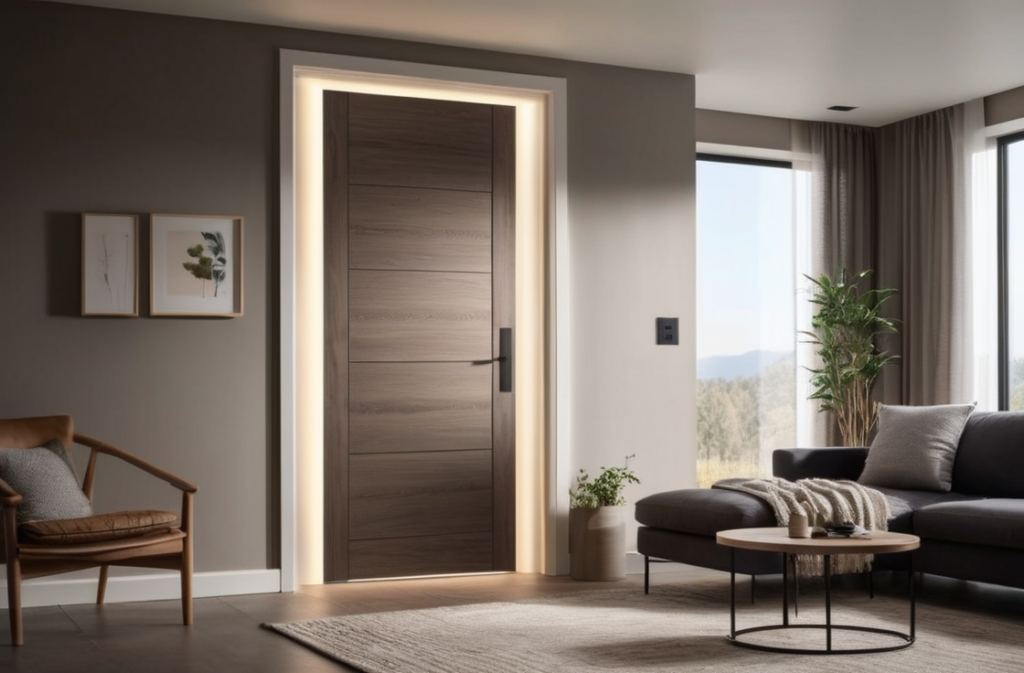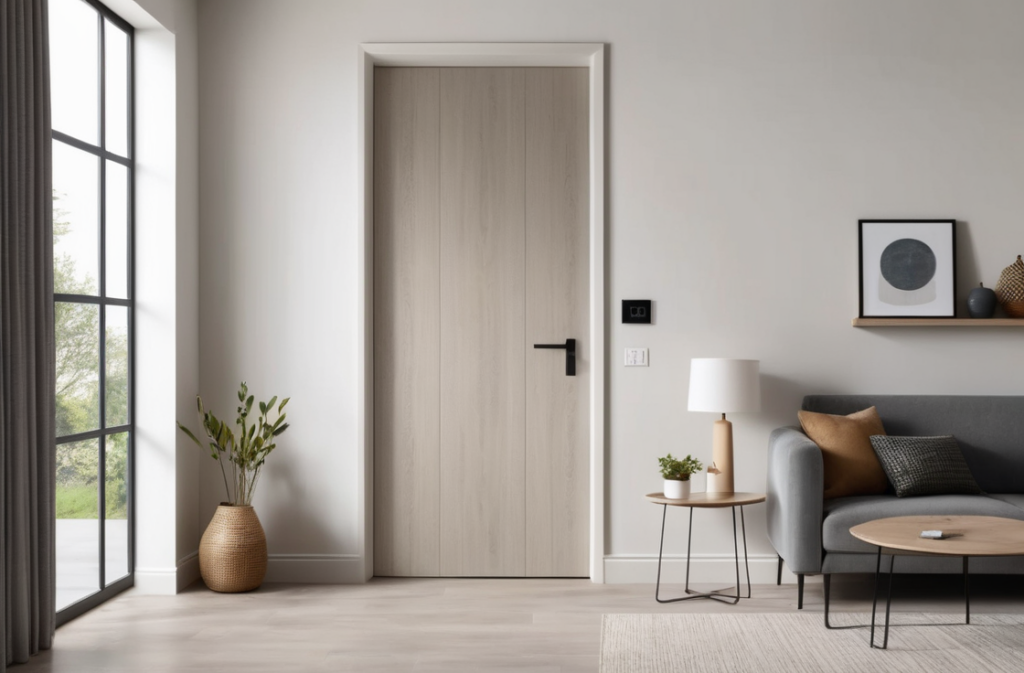What is WPC door?
The WPC door, or door composed of wood, is a built door of a combination of wood fibers or wood and thermoplastic flour. The combination creates a lasting, elastic and friendly material with the doors. WPC doors resist rot, insects and humidity, and can be installed in several applications, both interior and exterior uses. They mimic the aesthetics of natural wood but with some benefits, such as low maintenance and dimensional stability. WPC doors are favored because they are lasting, ecological and highly versatile for any architectural and design requirement.
Is WPC better than wood?
WPC (Wood-Plastic Composite) and natural wood comparison is partly based on reason and application-specific. Each has some plus points as well as limitations, and one’s choice is largely a user’s preference and requirement. Some following points can be used for WPC and natural wood comparison:

1).Advantages of WPC over Natural Wood:
Durability: WPC is more durable than natural wood because it is resistant to insect, rot and decay. WPC weather-resistant is also for extreme weather conditions and is less likely to damage moisture.
Low Maintenance: WPC is less maintenance than natural wood. WPC does not need to be painted, sealed or stained as often as natural wood, reducing the time and effort taken to keep it in excellent position.
Dimensional Stability: WPC is less susceptible to heat and moisture fluctuations, providing it better dimensional stability than wood. This indicates that over time can carry, swelling or shrink.
Environmental Impact: In some cases WPC can be considered more environmentally friendly, as it often contains recycled materials and reduces the demand for virgin wood.
Versatility: WPC comes in different colors, finishes and styles, giving a wide range of design options. It can also mimic the appearance of natural wood when providing the benefits of composite materials.
2).Advantages of Natural Wood:
Authenticity and Aesthetics: Natural wood has a unique, authentic beauty that is often precious for its warmth and character. Some people prefer the natural appearance of wood on the fake look of composite.
Sustainability: When sourced responsibly, wood from well -managed forests can be a durable and renewable resource. The certification system like FSC (One Stewardship Council) ensures responsible forestry practices.
Repairability: While natural wood can be susceptible to damage, it can often be repaired more easily than WPC. Scratches, dents and other surface issues can be addressed through sanding and refining.
Biodegradability: Natural wood is biodegradable, which means that it can naturally disintegrate at the end of its life cycle. WPC, being a holistic material, may not disintegrate in the same way.
3).Considerations:
Cost: The WPC door may have the highest cost, but long -term maintenance savings can offset this.
Application: The choice between WPC and natural wood may be based on specific application, such as outdoor decking, interior flooring or door construction.
In summary, the decision between WPC and natural wood is based on factors such as specific application that the desired aesthetic, environmental consideration, maintenance choices and materials will be used. Each material has its qualifications, and the best choice will change based on individual needs and priorities.
What are the disadvantages of WPC doors?
While the WPC (Wood-Plastic Composite) has different benefits of the door, it is important to be aware of some potential disadvantages. Here are some drawbacks associated with WPC doors:
Cost: WPC doors can be more expensive compared to some traditional materials, including some types of wood. The initial investment may be higher, although it may be offset by low long -term maintenance costs.
Appearance: When WPC can mimic the look of natural wood, some people can choose the authentic look and realization of real wood. WPC’s simulated grain and texture will not completely mimic the uniqueness of natural wood.
Limited Thickness Options: WPC doors may have limits in terms of thickness options compared to solid wooden doors. This can affect the overall rigidity and weight of the door.
Not Completely Biodegradable: When natural wood is biodegradable, WPC is a composite material that may not decompose in the same way. Disposal of WPC products can increase environmental concerns, especially if recycling features are not readily available.
Heat Resistance: WPC doors may not be as heat resistant as some other materials. Extreme heat causes deformation or damage to the door, so it may not be suitable for application where temperatures are concerned with exposure to the temperature.
Limited Repairability: When WPC is durable, improving any damage such as Deep Wanda Scratch or Dents, cannot be as straightforward as natural wood repairs. Damage to the surface can be more visible and challenging to improve.
Limited Load-Bearing Capacity: WPC doors may have limitations in terms of load-bearing capacity compared to some hardwood doors. These applications may be considered where the door is expected to bear heavy burden.
Sensitivity to UV Rays: Some WPC products are sensitive to direct exposure to UV rays and can fader or change color when they are exposed for a long time. This may be a consideration for exterior doors or doors exposed to direct sunlight.
It is essential to balance these points carefully against their own requirements and preferences when deciding between WPC doors and alternative materials. Despite these disadvantages, WPC doors remain an excellent option for many due to their general durability, under maintenance and environmental benefits on some traditional materials.

What are the types of WPC doors?
WPC doors come in various types, including interior doors, outer doors, sliding doors and folding doors, to offer flexibility for various personal applications and preferences.
Where can WPC doors be applied?
WPC (Wood-Plastic Composite) doors can be applied in a variety of settings, including residential interior (bedroom, bathroom, Vard Wardobs), commercial spaces (OFFICES fisso, retail stores), home-made, healing, healing, healing, healing, healing. And Outdoor Thrice, Thalkor). WPC door versatility, with their durability and resistance to moisture, insects and decay, makes them suitable for a wide range.
Is WPC door waterproof?
Yes, WPC (Wood-Plastic Composite) doors are known for their waterproof properties. A combination of wooden fibers or wooden flour with thermoplastic polymer in WPC creates a material that is resistant to water absorption. This feature makes WPC doors suitable for use in areas where there is concern for moisture like bathroom and kitchen. WPC’s waterproof nature helps prevent issues such as swelling, V ping ring or decay that can be caused by traditional wooden doors when contacting moisture over time. However, it is important to note that when WPC doors are very resistant to water, the appropriate installation and maintenance methods are still crucial to ensure long -term influence and durability.
How many years is the lifespan of WPC doors?
The life expectancy of the WPC doors is usually over 15 years, accidental on factors such as material quality, production processes, environmental conditions and maintenance methods.
Can WPC doors be customized?
WPC doors can be customized to meet specific requirements and preferences. Personalization options include variations in size, design, color and finish. Manufacturers often offer different styles for addressing many architectural and aesthetic preferences. This flexibility allows customers to customize the WPC doors for residential and professional applications, ensuring that the doors are integrated without problems without normal design and space problem. In addition, the use of customization can be expanded in characteristics such as hardware, glass inserts and other design elements. The ability to adapt to the WPC doors makes them a versatile option, which provides a balance between certified options and individual solutions to meet individual needs.
WPC wood production process (wood plastic compound) usually indicates the following steps: First for the formation of wood compound material, wooden fibers or wooden flour thermoplastic polymer, often mixed with polyethylene or polypropylene. Then, the mixture is processed in the desired shape, such as using panels and door frames, extrusion or compression molding techniques. After the formation of the door contour in the mold, the composite material goes through the treatment of high temperature and high pressure to guarantee full fusion and strong union. Finally, the product cools and is cut to produce WPC wooden doors that meet the specifications. This manufacturing process imparts durability, shape stability, moisture resistance and low maintenance characteristics at the doors of WPC.
WPC doors easy to install and maintain?
WPC doors are simple to install and low maintenance. The WPC’s lightness makes it easy to handle during installation, and assembly is typically that of an easy puzzle, without the requirement of much in tools. WPC doors are also easily cut to spaces and sizes desired. With minimal maintenance requirements, they are resistant to insects, rot, and moisture, so there are fewer repairs required. Normal cleaning is normally sufficient to keep them in decent shape and appearance. Overall, the simplicity of installation and low maintenance needs make WPC doors a handy and reliable solution for numerous applications.
How to purchase WPC doors from Hanse?
To buy WPC (Wood-Plastic Composite) doors from China, start by researching reputable suppliers. Take part in the Plat Neline Platform, Industry Directors, or Trade Shows to identify potential manufacturers. Contact suppliers to inquire about product specifications, prices and conditions. Verify their credentials, certificates and customer reviews. Clearly contact your customization requirements and request detailed quotes, including shipping costs and delivery time. Consider ordering templates for quality inspection. Negotiate the terms, finalize the ORDER Rider and get Proforma in Oice Is. If applicable, attach a third-party inspection service for quality control. Coordination of shipping logistics and customs clearance, working with freight forwarders or shipping agents. Carefully planning and communications will help ensure successful and satisfactory purchase of WPC doors from China.
Hains wood doors are a prestigious and professional factory specialized in cautious crafts of wooden door production. Famous for its uninterrupted commitment to excellence, Hans has made it a special for himself in the industry, which offers an example of traditional craftsmanship and modern innovation fusion.
Hense is a team of skilled craftsmen and craftsmen at the center of the wooden door that brings years experience and skills to the art of wood work. The factory is equipped with state -of -the -art machinery and cutting edge technology, ensuring precision, efficiency and ability to meet various design choices.
Hains wood doors are proud to offer a broad spectrum of wooden doors from classic to contemporary styles. Each door is cautiously formed, paying attention to detail, design and functionality. The use of premium quality wood not only guarantees aesthetic appeal of the door but also their durability and longevity.
The production process at Hains includes the integrated integration of traditional techniques with modern methods. This harmonious mixture results in the door that not only reflects the elegance but also meets the demand for contemporary life. The factory commitment to durability is clear by responsible source -friendly methods and environmentally friendly production methods.
Hains understand the importance of customization of wooden doors. The factory is adept at preparing its products to meet individual design requirements and preferences. Whether it is complex detail, specific dimensions or unique finishes, goose ensures that each door of the wood is a bespock masterpiece.
The customer’s satisfaction is at the root of the morality of the Hans wooden door. The factory emphasizes quality control measures, ensuring that each door leaves its premises and adheres to the highest standards. From residential to commercial projects, Hans has become a reliable name, which provides doors that serve not only functional elements, but also contribute to the overall aesthetics of the spaces.
In conclusion, Hans wooden doors are higher than the factory; It is a symbol of craftsmanship, innovation and commitment to delivering wooden doors. By focusing on quality, customization and durability, Hans becomes a reliable and leading power in the field of wooden door production.




